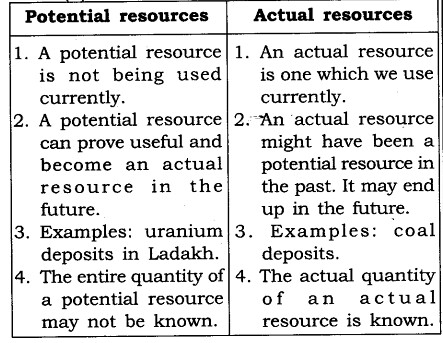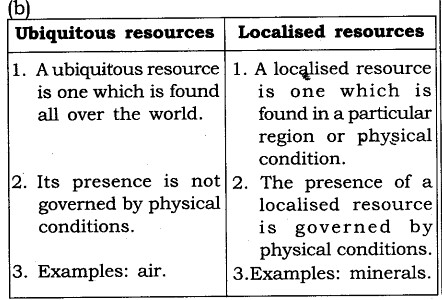NCERT Solutions Class 8 Geography Resources and Development Chapter 1 – Resources
WELCOME TO GEOGRAPHIA_ www.geographia97.blogspot.com NCERT Solutions for Class 8 Geography Chapter 1 – Resources are provided here for students to study and score good marks in the exams. Anything that can be used to satisfy a need, from the water you drink to the electricity you use in your house and the rickshaw you used to get home from school, are all considered resources. All these objects have been used by you, so they have utility. Utility or usability is what makes an object or substance a resource. We have compiled here the NCERT Solutions to the exercises, which will be useful for school exams, as they are sourced from the NCERT textbooks.
Chapter 1 – Resources Summary
Chapter 1 of Resources and Development deals with various types of resources available for the existence on the earth.
Students will learn about human-made and natural resources and the current status of these resources.
The students will also get to know about the following topics:
- Types of resources
- The need for conservation of resources
- Human-made resources
NCERT Solutions for Class 8 Geography Chapter 1 – Resources
1. Answer the following questions.
- A substance becomes a resource if it has utility
- time. and technology are two important factors which make a substance a resource.
- On the basis of the level of development, resources are classified into actual and potential
- An actual resource to crazy might have been a potential resource some time ago.
- Windmills generate wind.energy which is a resource because it will never end up.
- Although renewable resources can be replenished, we should be careful regarding their use.
- Coal and petroleum are examples of non-renewable resources.
- Air is a ubiquitous resource since it is found everywhere
- Physical factors affecting the presence of a localised resource are terrain, altitude, climate
- Using resources carefully and giving them time to get renewed is called resource conservation.
Choose the correct option.
(i) Which of these is not a resource?(a) the Indian Prime Minister
(b) your Geography book
(c) a small piece of paper
(d) none of these
(ii) Which of these does not have economic worth but is valuable?
(a) shoes
(b) mountains
(c) coal
(d) none of these
(iii) The types of resources on basis of stock are
(a) ubiquitous and localised
(b) actual and potential
(c) renewable and non-renewable
(d) abiotic and biotic
(iv) Which of the following is a non-renewable resource?
(a) solar energy
(b) water
(c) soil
(d) natural gas
(v) Which of these is an example of sustainable development?
(a) ignoring the lights when they are switched on but not required
(b) not wasting paper
(c) using coal and petroleum deposits at a fast pace
(d) none of these
Class 8 Geography Chapter 1 Resources Very Short Answer Type Questions
Question 1.
What is the condition for a substance to be called a resource?
Answer:
A substance needs to have some utility to be called a resource.
Question 2.
What do you understand by the word “utility”?
Answer:
If a substance can be used in any way, it is said to have a utility.
Question 3.
What are the natural resources?
Answer:
Resources that are drawn directly from nature are called natural resources.
Question 4.
What is the name given to the type of resources that have limited stock?
Answer:
The resources having limited stock are called non-renewable resources.
Question 5.
How are resources classified according to their distribution?
Answer:
On the basis of their distribution, resources are classified into ubiquitous and localised.
Question 6.
Give three examples of abiotic resources.
Answer:
Air, land, soils.
Question 7.
How are human-made resources different from natural resources?
Answer:
Human-made resources have been created by human beings, whereas natural resources are provided by nature.
Question 8.
What is human resource development?
Answer.
Improving the quality of human skills in order to make them more useful is called human resource development.
Class 8 Geography Chapter 1 Resources Short Answer Type Questions
Question 1.
Explain the terms of resource conservation and sustainable development.
Answer.
Resource conservation is the concept of using resources carefully so that they do not end up quickly. The future generations also need the resources, but if we keep using them at a fast pace, they may end up, thus posing problems for the future. We should use resources in such a balanced way that we satisfy our needs as well as conserve them for the future. This concept is called sustainable development.
Question 2.
Why are human beings resources?
Answer.
Human beings are intelligent living beings. They can use their intelligence to realise the utility of substances. Had there been no humans, the resources would not have been resources. Human beings are interdependent on each other, and they prove useful to each other. For example, a postman renders us an important service, so he is a resource.
Question 3.
Explain how resources are classified broadly.
Answer.
Resources are broadly classified into natural, human-made and human. Natural resources are those that are taken from nature. They are used without modifying them, i.e. in the same form as they exist in. Rivers, lakes, air, soils, minerals, trees, mountains, etc. are natural resources. Human-made resources have not been provided to us by nature. Human beings have used their intelligence to manufacture them for their own use. Examples include vehicles, buildings, roads, telephones, etc.
Human resources include people who serve us in any way. A teacher, doctor, carpenter, cobbler, etc. are human resources.
Question 4.
Write a short note on the significance of time and technology in making a substance a resource.
Answer.
Time and technology are important factors in making substances resources. With time, technology develops. As technology develops, we begin to discover new ways to make life better. In this process, certain substances which were useless to us earlier become useful. An invention and discovery give us new resources. An example is a hydroelectricity. This technology has made water a source of electricity.
Thank you for visiting this page.
Sayantani Singh
SAYANTANI SINGH Msc, B.Ed
GEOGRAPHIA
If you want to join my telegram group
YOU TUBE CHANNEL LET'S LEARN GEOGRAPHY click here
NCERT CLASS_6 SHORT NOTE CLICK HERE
NCERT CLASS _6 SOLUTION CLICK HERE
ICSE class -ix click here
ICSE class -x click here
CLASS 6 WBBSE GEOGRAPHY CLICK HERE
জলবায়ুর শ্রেণীবিভাগপ্রশ্ন-উত্তর click here
REGIONAL THEORIES CLICK HERE
দ্বাদশ শ্রেণী ভূগোল CLICK HERE
CURRENT AFFAIRS CLICK HERE
NOTES OF HUMAN GEOGRAPHY AND AND POPULATION GEOGRAPHY click here
CONTINENTAL DRIFT THEORY BY FB TAYLOR CLICK HERE
CONTINENTAL DRIFT THEORY BY TAYLOR IN BENGALI CLICK HERE
CONTINENTAL DRIFT THEORY BY WEGNER CLICK HERE
CLIMATE OF INDIA CLICK HERE
ভূমিরূপ গঠন কারী প্রক্রিয়া ; উচ্চমাধ্যমিক ভূগোল click here
বহির্জাত প্রক্রিয়া ও তার ফলে সৃষ্ট ভূমিরূপ click here
মহিসঞ্চারন তত্ত্ব click here
Ugc net 2007 june paper 2 geography click here
Ugc net 2006 december paper 2 geography click here
UGC NET GEOGRAPHY 2007 DECEMBER CLICK HERE
UGC NET GEOGRAPHY 2008 JUNE CLICK HERE
WB CLASS 6 GEOGRAPHY CHAPTER 4 CLICK HERE
UGC NET GEOGRAPHY 2009 JUNE CLICK HERE
PLATE TECTONIC THEORY CLICK HERE
NCERT CLASS 7 GEOGRAPHY CLICK HERE
CORAL REEF IN BENGALI NOTE CLICK HERE
CORAL REEF CLICK HERE
HS GEOGRAPHY CLICK HERE
Thank you for visiting this page.we provide geography related study materials on daily basis..









0 Comments